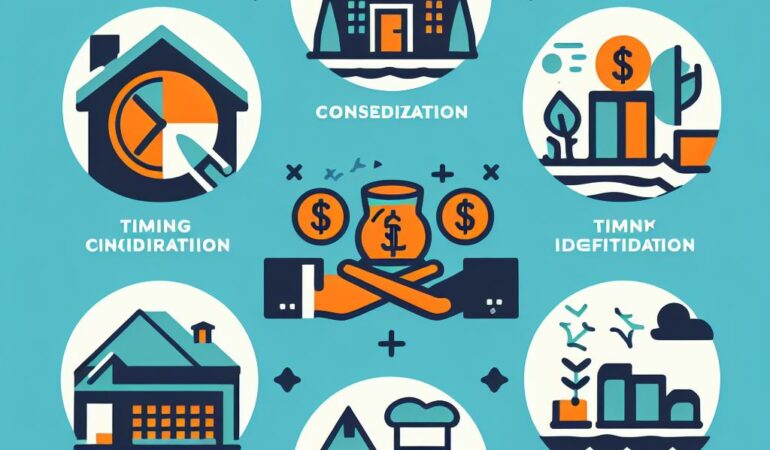Looking to save on taxes during a 1031 exchange? You’re in luck! We’ve got the top five strategies that will help you maximize your savings.
From timing the exchange just right to properly identifying replacement property, we’ve got you covered.
And don’t forget about utilizing the 45-day rule and maximizing depreciation benefits.
Plus, we’ll even dive into the world of reverse exchanges.
Get ready to save big on your taxes with these top-notch strategies!
Key Takeaways
- Timing and adhering to deadlines is crucial for a successful 1031 exchange and to preserve tax advantages.
- Proper identification of replacement property within 45 days is essential, with specificity and clarity being important.
- Utilizing the 45-day rule effectively involves starting early, conducting thorough research, and consulting with professionals.
- Maximizing depreciation benefits can be achieved by choosing a replacement property with a higher depreciation schedule and considering improvements or renovations.
Timing of the Exchange
Timing is crucial when it comes to executing a successful 1031 exchange for tax savings. To ensure you maximize your benefits, it’s important to understand the timing requirements involved in this process.
Firstly, you need to identify a replacement property within 45 days of selling your original property. This is a strict deadline, and failing to meet it will disqualify your exchange. It’s recommended to start your search for a replacement property as soon as possible to allow ample time for due diligence and negotiations.
Secondly, you must close on the replacement property within 180 days of selling your original property. This timeline includes both the 45-day identification period and the additional 135 days for closing. Again, it’s crucial to stay within this time frame to preserve the tax advantages of a 1031 exchange.
Additionally, be aware of the calendar year-end. If your 45-day identification period or 180-day exchange period falls near the end of the year, you may need to adjust your timeline accordingly to avoid potential tax consequences.
Proper timing is essential for a successful 1031 exchange. By understanding and adhering to the deadlines, you can take advantage of the tax savings this strategy offers.
Proper Identification of Replacement Property
To ensure a successful 1031 exchange for tax savings, it’s crucial that you properly identify the replacement property. This step is essential because it determines the properties that can be considered for your exchange.
When identifying replacement property, it’s important to keep a few key points in mind.
First, you must identify the potential replacement property within 45 days of selling your relinquished property. This 45-day rule is strictly enforced by the IRS and failing to meet this deadline can result in disqualification of your exchange.
Second, you’re allowed to identify up to three replacement properties, regardless of their value. However, if you wish to identify more properties, there are additional rules and restrictions that apply.
Lastly, it’s important to be specific and unambiguous in your identification. This means providing a clear description or address of the intended replacement property.
By properly identifying your replacement property, you set the foundation for a successful 1031 exchange.
Now, let’s delve into the next section about utilizing the 45-day rule to further maximize your tax savings.
Utilizing the 45-Day Rule
Are you aware of how to effectively utilize the 45-day rule to maximize your tax savings in a 1031 exchange?
The 45-day rule is a crucial aspect of a successful exchange, and understanding how to make the most of it can significantly impact your tax benefits.
Here are three strategies to help you utilize the 45-day rule effectively:
- Start early: As soon as you sell your relinquished property, begin searching for potential replacement properties. Time is of the essence, and starting early will give you more options and increase your chances of finding suitable replacement properties within the 45-day timeframe.
- Be thorough in your research: Conduct a comprehensive analysis of potential replacement properties to ensure they meet your investment goals. Consider factors such as location, rental income potential, and long-term appreciation. This thorough research will help you make an informed decision and maximize your tax savings.
- Consult with professionals: Engage the services of a qualified intermediary and a tax advisor who specialize in 1031 exchanges. They can provide valuable guidance throughout the process and help you navigate any complexities that may arise.
By effectively utilizing the 45-day rule, you can identify and acquire replacement properties that align with your investment objectives while maximizing your tax savings.
Now, let’s explore another essential aspect of tax savings in a 1031 exchange: maximizing depreciation benefits.
Maximizing Depreciation Benefits
To maximize your depreciation benefits in a 1031 exchange, it’s important to carefully analyze and consider the potential tax advantages of the replacement property. Depreciation is a valuable tax deduction that allows you to recover the cost of your investment property over time. By understanding how to maximize depreciation benefits, you can significantly reduce your taxable income and increase your overall tax savings.
One strategy to maximize depreciation benefits is to choose a replacement property that has a higher depreciation schedule. The IRS provides different depreciation schedules for different types of properties, such as residential or commercial. By selecting a property with a shorter depreciation schedule, you can accelerate your depreciation deductions and increase your tax savings.
Another strategy is to consider purchasing a property that requires significant improvements or renovations. This is because the cost of these improvements can be depreciated over time, providing you with additional deductions. However, it’s important to carefully analyze the potential tax benefits of these improvements and ensure that they’ll result in a positive return on investment.
Additionally, it’s crucial to maintain detailed records of all expenses related to the replacement property. This includes not only the purchase price but also any costs associated with improvements, repairs, and maintenance. By keeping accurate records, you can maximize your depreciation deductions and ensure that you’re taking full advantage of all available tax benefits.
Understanding Reverse Exchanges
If you’re considering a 1031 exchange, it’s important to understand reverse exchanges. This strategy allows you to acquire a replacement property before selling your current property, which can be beneficial in a competitive real estate market.
Here are three key points to help you understand reverse exchanges:
- Identification Period: In a reverse exchange, you have 45 days to identify the property you want to sell (relinquished property). However, you must also identify the replacement property within 45 days of acquiring it. This means you need to plan your exchange carefully to ensure you meet the deadlines.
- Exchange Accommodation Titleholder (EAT): To facilitate a reverse exchange, you’ll need an EAT. The EAT holds the title to the replacement property while you sell your relinquished property. This allows you to defer taxes while maintaining control over the properties involved in the exchange.
- Time Constraints: Reverse exchanges have strict time constraints. You must complete the exchange within 180 days, including both the identification period and the exchange period. It’s crucial to work with experienced professionals to ensure compliance with all the requirements.
Understanding reverse exchanges is essential for maximizing the benefits of a 1031 exchange. Consult with a qualified tax advisor or intermediary to navigate this complex process effectively.
Frequently Asked Questions
Can I Use a 1031 Exchange for Personal Property, Such as My Primary Residence?
You can’t use a 1031 exchange for personal property like your primary residence. The 1031 exchange is specifically for investment properties. Consult a tax professional for personalized advice.
What Are the Potential Tax Consequences if I Fail to Properly Identify Replacement Property Within the Specified Timeframe?
If you fail to properly identify replacement property within the specified timeframe, the potential tax consequences can be significant. You may end up paying capital gains taxes on the sale, which could result in a substantial financial loss.
Are There Any Limitations or Restrictions on the Types of Properties That Qualify for a 1031 Exchange?
There are limitations and restrictions on the types of properties that qualify for a 1031 exchange. To be eligible, the properties must be held for investment or business purposes and cannot be personal residences.
How Can I Ensure That I Maximize the Depreciation Benefits When Engaging in a 1031 Exchange?
To maximize depreciation benefits in a 1031 exchange, identify and invest in properties with higher depreciation schedules. Seek advice from a tax professional to ensure you’re utilizing all available strategies.
What Are the Main Differences Between a Forward Exchange and a Reverse Exchange, and When Would It Be Advantageous to Choose One Over the Other?
To maximize your depreciation benefits in a 1031 exchange, you should consult with a tax professional who can help you navigate the specific rules and regulations that apply to your situation.




